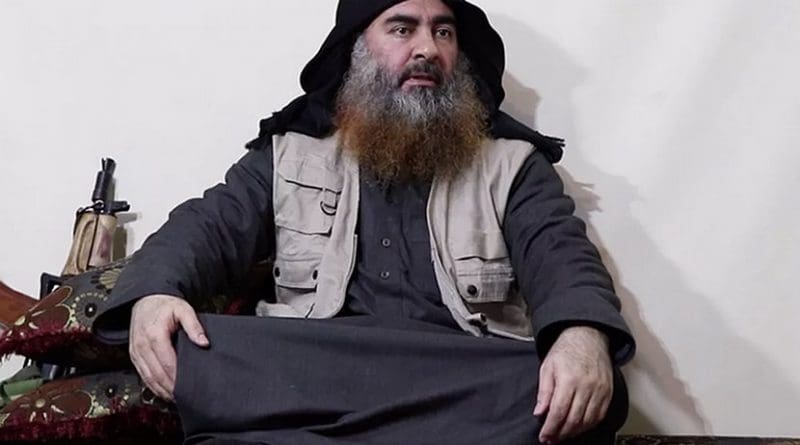Muhammad Saiful Alam Shah Bin Sudiman*
 Last month, the Singapore authority issued an Order of Detention (OD) under the Internal Security Act (ISA) to a 40-year-old unemployed Singaporean. Another two, a 39-year-old man and a 62-year-old woman were issued with Restriction Orders (RO) under the ISA for their involvement in terrorism-related conduct. These development proves that just like IS persuasive narratives, the support for the false IS caliphate is still lurking large.
Last month, the Singapore authority issued an Order of Detention (OD) under the Internal Security Act (ISA) to a 40-year-old unemployed Singaporean. Another two, a 39-year-old man and a 62-year-old woman were issued with Restriction Orders (RO) under the ISA for their involvement in terrorism-related conduct. These development proves that just like IS persuasive narratives, the support for the false IS caliphate is still lurking large.
Eleven months ago the self-proclaimed IS caliphate Abu Bakar Al-Baghdadi delivered an audio speech which was made accessible on the Internet on 22 August 2018. 1 The speech was designed to boost IS supporters’ fighting spirits amid coalition forces massive military operations against them in their controlled land in the Middle East. As the territorial defeat of the so-called Islamic State was inching closer, the self-proclaimed caliph was quick to reconstruct new narratives.
The first narrative is when Al-Baghdadi quoted the Quran 2:155 to encourage patience in fighting its adversaries. 2 Despite the imminent defeat, he stressed that those who are loyal to the group would be the clear winners in the sight of God. He added that loss of life and territorial defeat should not be the cause of despair. Here, lies the significance of the referenced verse. By forsaking the context of the verse, Al-Baghdadi conditions the mind of his followers by affirming that regardless of the result of the war, they will emerge triumphant in the eyes of God. This produces a perpetual win-win mindset that discredits the slightest worry of defeat.
The second narrative is when Al-Baghdadi presented the concept of tamhis (Arabic for purification) to IS followers. Al-Baghdadi quoted Qur’an 2:214 to assert that the loss of souls and lands in warfare is a purification process. 3 Accordingly, he claimed that those who survive this trial are the true believers and they are the selected ones who will continue the struggle to establish the religion. This message is crucial to win the trust of its supporters and to reaffirm that IS will keep its motto of ‘remaining and expanding’ alive. It is a timely message to compensate for the waning image of the caliphate.
Al-Baghdadi made a surprise appearance on 30 April 2019 through an eighteen-minute video in late April 2019. 4 In the video, Al-Baghdadi conceptualised IS persistent military operation as a work of istinzaf 5; Arabic for attrition of strengths and confidence as the third narrative 6. This concept underlines the importance of relentless military engagement or jihad against the enemies of God. In addition to the quest to establish Islam and ‘Shari’ah-based governance’, the jihad aims to cause depletion of resources of IS adversaries by targeting their human capital, military might, economy and logistic. In many reports, istinzaf refers to ‘bleed them (the enemy).’ Al-Qaeda had also used a similar notion. In one of his speeches, Ayman Al-Zawahiri stated the purpose of targeting America “is to exhaust her and bleed her to death, so that it meets the fate of the former Soviet Union and collapses under its own weight as a result of its military, human, and financial losses. 7” This particular point binds the two terror groups in terms of its long term terror campaign strategy.
The fourth which is a rather impactful narrative was meant to address the anxiety over the collapse of the caliphate. Al-Baghdadi explained that the ongoing fighting is a form of a perpetual jihad that does not guarantee victory, “God ordered us to wage jihad. He did not order us to win. 8,9” This statement reshapes the established belief among IS fighters that the group must emerge victorious in every battle by virtue of their allegiance to God.
From a proto-state to a clandestine guerrilla movement, IS’ present condition has forced Al-Baghdadi to reinvent narratives that loosens its supporters’’ grip on the previously ‘religiously-backed evidence’ that was presented to the world for almost five years to insist on IS legitimacy. Hence, the message for every IS fighter is to continue fighting until the end of time, whether or not there will be another ‘physical’ Islamic State in the near future.
With this, countries especially those that were targeted in the past should begin to take measures that minimise chances of an attack to occur. More importantly, is to start to identify the probable breeding ground and to disrupt its operations and connections. Sri Lanka’s action of expelling 200 over-stayed foreign Muslim preachers in the aftermath of Easter Day bombings is a plausible way forward 10.
Local population is the receiving end in this psychological warfare because Islamist terror groups such as AQ and IS ‘perpetual war’ ideology is attacking the spirit of peaceful co-existence. Each attack potentially weakens the social fabric and instils distrust. In response, governments must creatively formulate initiatives that champion social resilience and unity, especially after an attack. In this regard, Singapore has something to offer in terms of its approach to educating the masses on how to respond in the event of a terrorist attack, namely the SGSecure movement.11
Simultaneously, efforts to help foster friendships and a shared conception of common good as a counterweight to animosity must continue especially in a multi-religious multi-racial society. This is a soft approach to counter-terrorism and its critical role should never be discounted.
No comments:
Post a Comment